DEVELOPING DEVREL METRICS & GOALS DEVRELCON EARTH 2020 @MARY_GRACE
A presentation at DevRelCon Earth 2020 in August 2020 in by Mary Thengvall
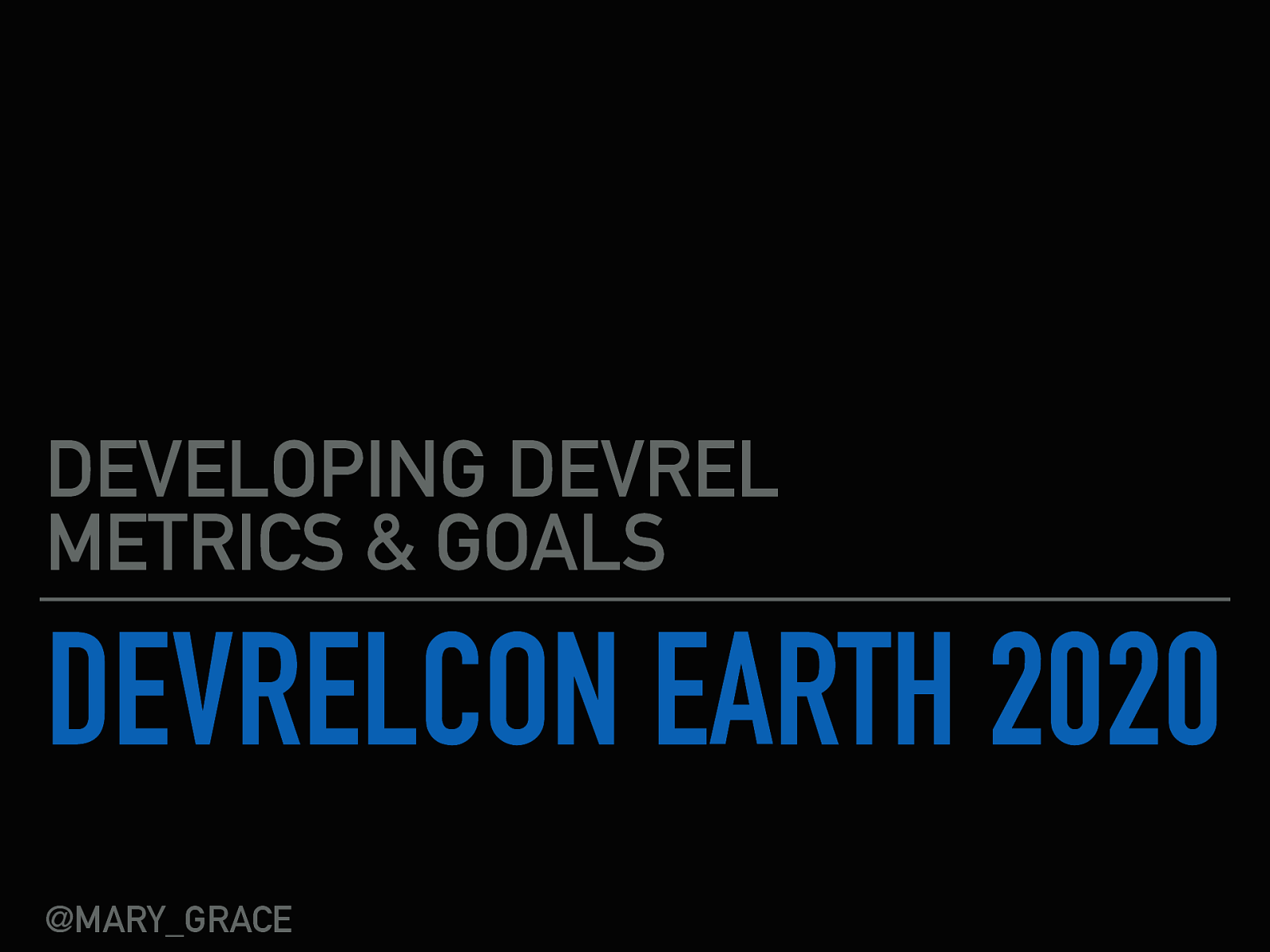
DEVELOPING DEVREL METRICS & GOALS DEVRELCON EARTH 2020 @MARY_GRACE
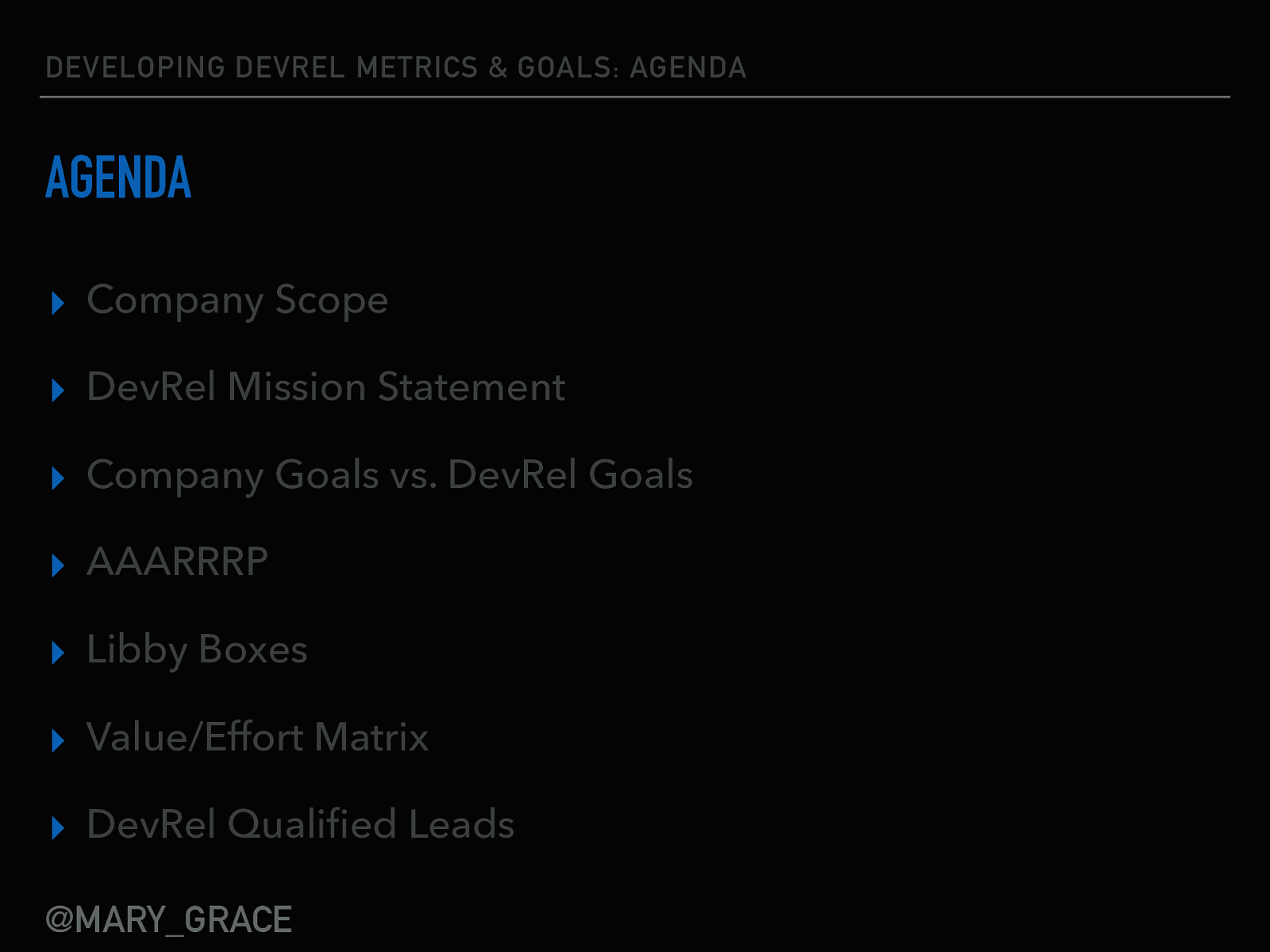
DEVELOPING DEVREL METRICS & GOALS: AGENDA AGENDA ▸ Company Scope ▸ DevRel Mission Statement ▸ Company Goals vs. DevRel Goals ▸ AAARRRP ▸ Libby Boxes ▸ Value/Effort Matrix ▸ DevRel Qualified Leads @MARY_GRACE Intro / Agenda Setting - 9:40am - 5m Company Scope & DevRel Mission Statement (lecture) - 9:45am - 10m * name * mission * goals Company Goals vs. DevRel Goals (lecture) - 9:55am - 15m * which goals DevRel can contribute to (where’s our biggest impact) AAARRRP (lecture) - 10:00am - 5m * Phil’s spreadsheet of possibilities Libby Boxes (lecture + interactive) - 10:15am - 40m (break in middle as people finish) * What are Libby Boxes? (history, meaning, purpose, etc.) * Decide on one goal (as a group) * Walk through top two boxes together (interactive) * Use Slack to curate ideas & put them in the correct boxes (share on screen) * Walk through all of the “dig deeper” and “reasonable measures of success” buckets. Input what the groups have come up with into Google Doc Value/Effort Matrix (lecture + interactive) - 10:55am - 30m * introduce idea * ask for input on how difficult things are and why they belong in that position on the chart * talk about strengths in the team — what’s easier for some won’t be as easy for others. play to strengths. look for areas of career progression. what excites you? what just has to be done? * dependencies * delegate, delete, do, ?? * if still too many post-it’s, which ones bring the most value with the least amount of effort? which ones have to be done first in order to unblock others? which ones have the most impact on the company versus the community? * ^ depending on your current status with the company will determine whether you’re in a comfortable place politically to focus on community versus company impact. DevRel Qualified Leads (lecture) - 11:25 - 15m * I rarely put them as their own item because they’ll be happening in the midst of everything else, but they’re absolutely a point on the map! (talk tomorrow to learn more about them specifically)
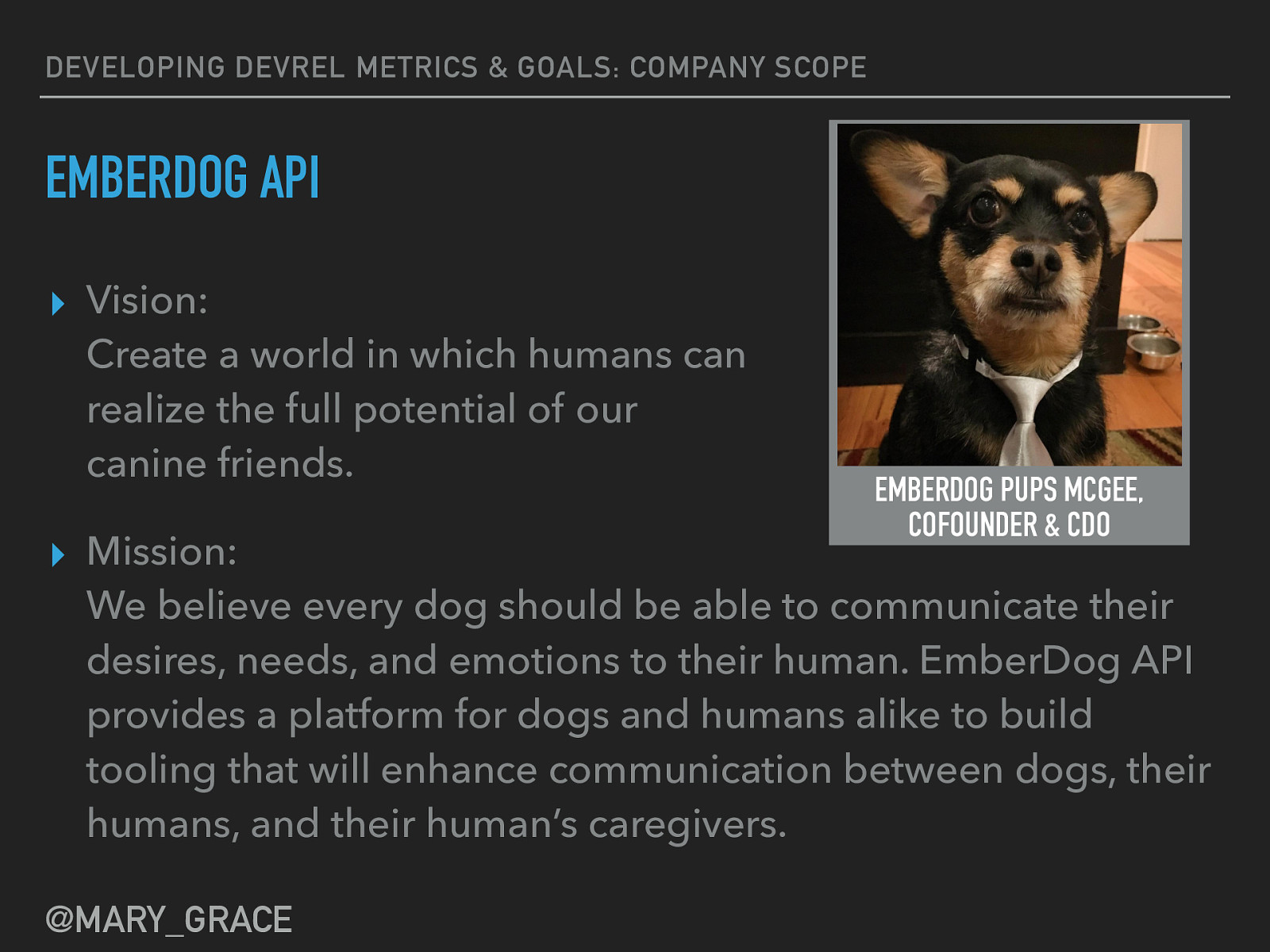
DEVELOPING DEVREL METRICS & GOALS: COMPANY SCOPE EMBERDOG API ▸ Vision: Create a world in which humans can realize the full potential of our canine friends. ASDA EMBERDOG PUPS MCGEE, COFOUNDER & CDO ▸ Mission: We believe every dog should be able to communicate their desires, needs, and emotions to their human. EmberDog API provides a platform for dogs and humans alike to build tooling that will enhance communication between dogs, their humans, and their human’s caregivers. @MARY_GRACE TIME CHECK: 9:45AM There’s a 5 person DevRel team at EmberDog API — a manager, 2 advocates, 1 technical writer, and a technical community builder.
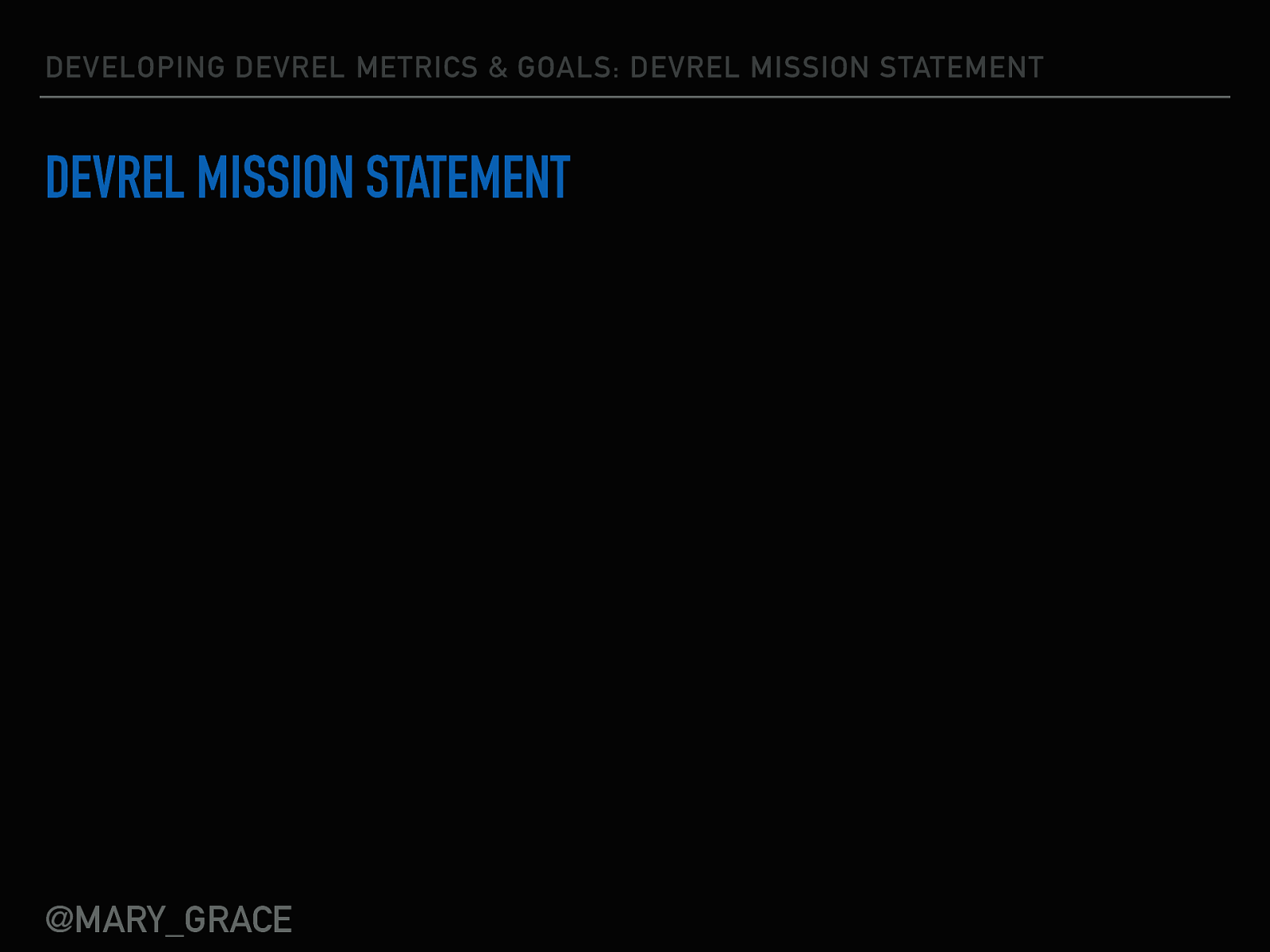
DEVELOPING DEVREL METRICS & GOALS: DEVREL MISSION STATEMENT DEVREL MISSION STATEMENT @MARY_GRACE We often talk about DevRel goals in the scope of awareness, developer experience, or advocacy, but that doesn’t help us narrow down why the DevRel team exists. After all, the marketing team could focus on developer awareness and content, the product team could work with engineering to finesse the docs, and the CTO, CEO, or other VPs throughout the company could be the outward-facing faces of the company. So what’s the actual need that DevRel is fulfilling? By answering this question, we can more easily define the mission of the DevRel team.
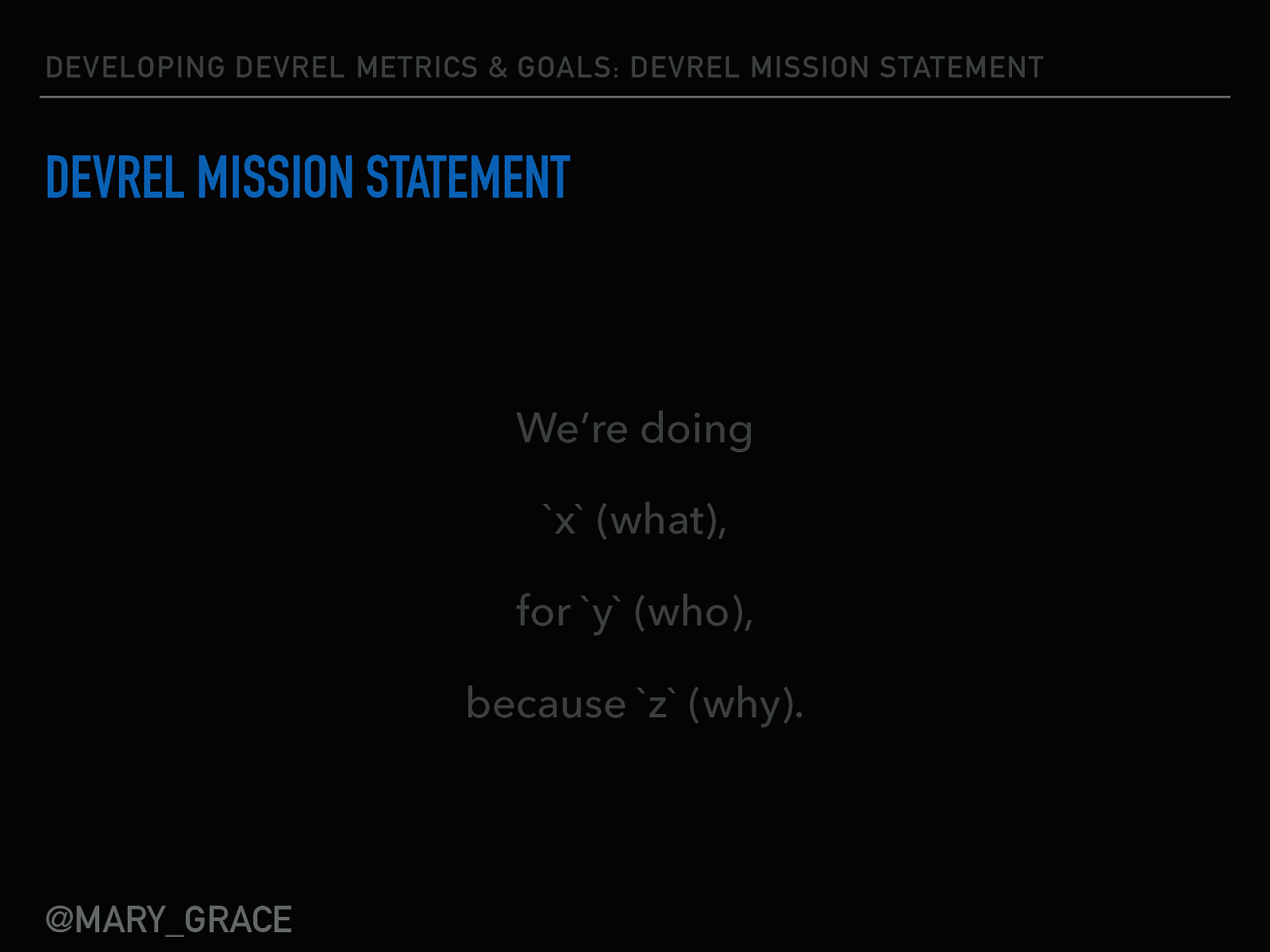
DEVELOPING DEVREL METRICS & GOALS: DEVREL MISSION STATEMENT
DEVREL MISSION STATEMENT
We’re doing x (what), for y (who), because z (why).
@MARY_GRACE This could be a wholly different workshop, but in short, the best mission statements include three sections: what, who, and why.
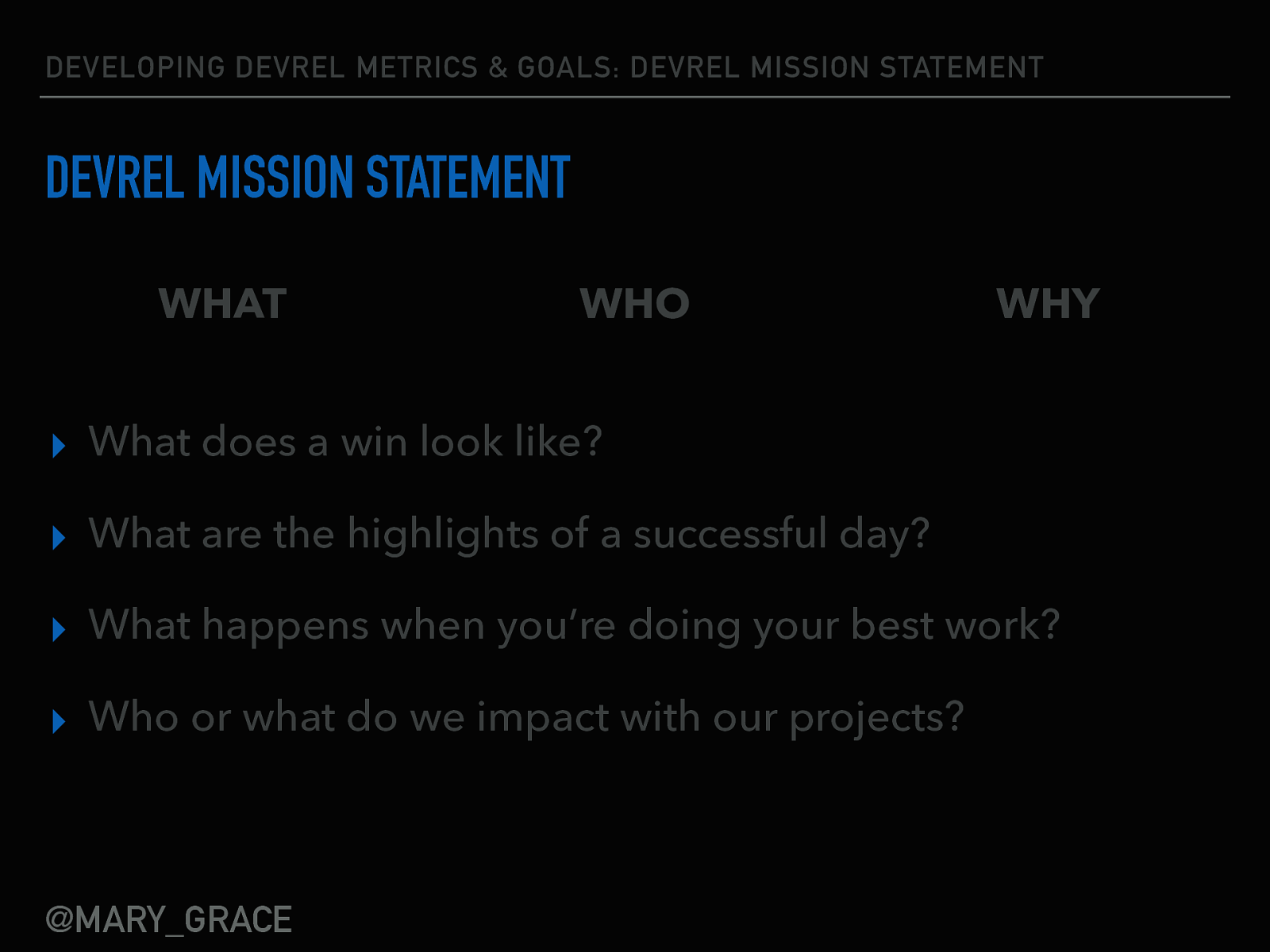
DEVELOPING DEVREL METRICS & GOALS: DEVREL MISSION STATEMENT DEVREL MISSION STATEMENT WHAT WHO WHY ▸ What does a win look like? ▸ What are the highlights of a successful day? ▸ What happens when you’re doing your best work? ▸ Who or what do we impact with our projects? @MARY_GRACE My favorite way to define the mission is by brainstorming what success means for the team: * What does a win look like? * What are the highlights of a successful day? * What happens when you’re doing your best work? * Who or what do we impact with our projects?
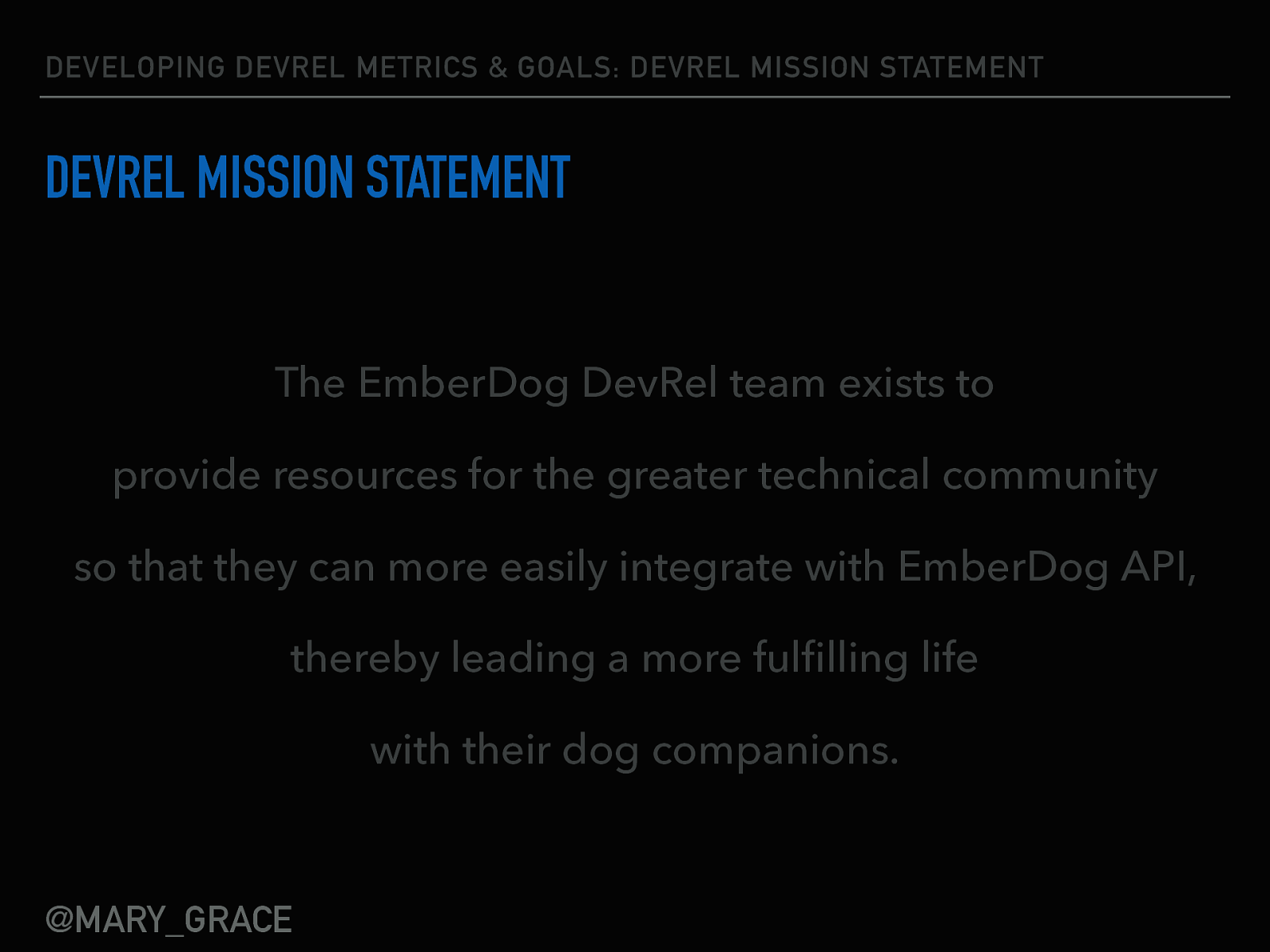
DEVELOPING DEVREL METRICS & GOALS: DEVREL MISSION STATEMENT DEVREL MISSION STATEMENT The EmberDog DevRel team exists to provide resources for the greater technical community so that they can more easily integrate with EmberDog API, thereby leading a more fulfilling life with their dog companions. @MARY_GRACE So here’s our DevRel mission statement for today’s exercise…
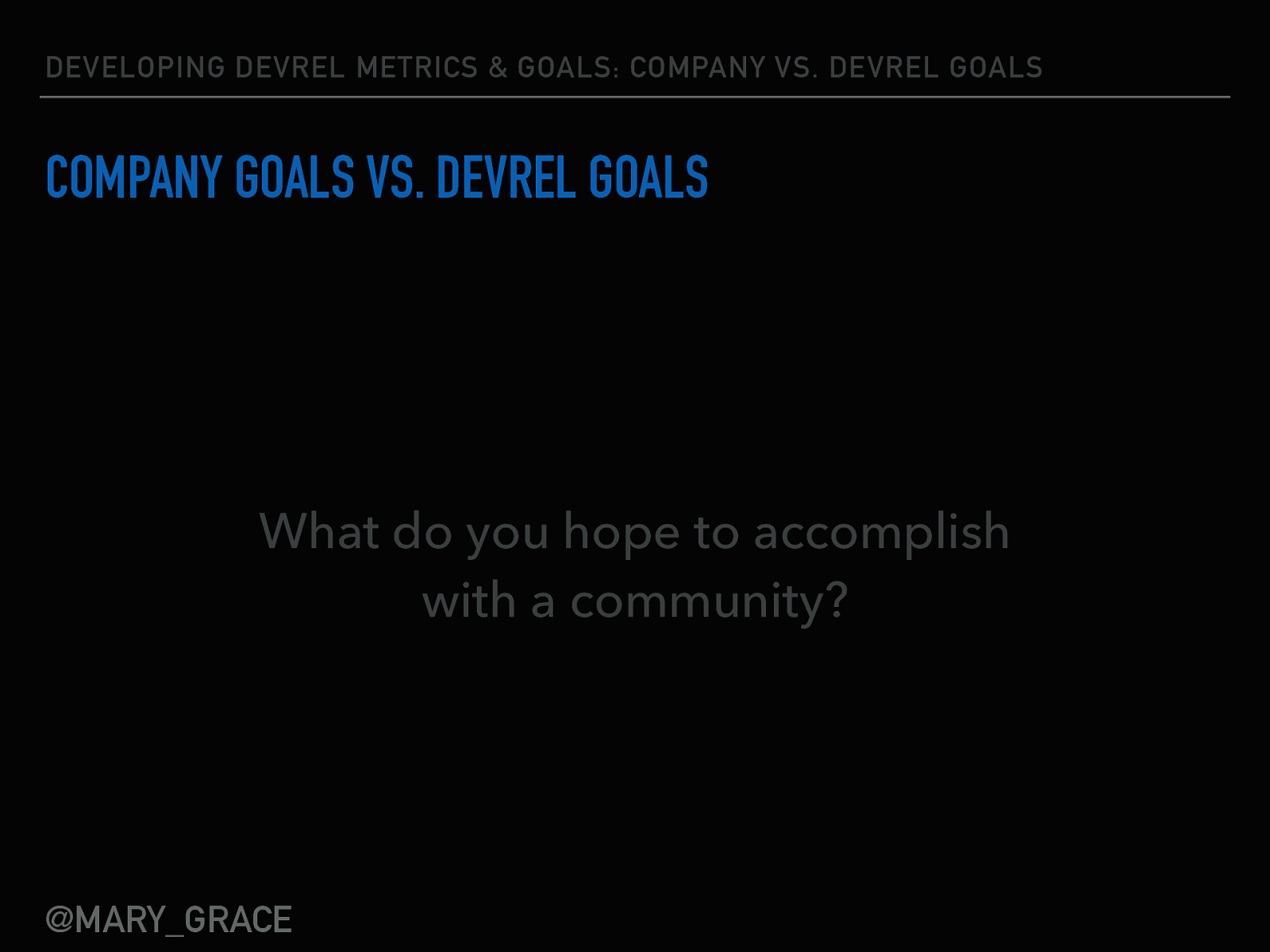
DEVELOPING DEVREL METRICS & GOALS: COMPANY VS. DEVREL GOALS COMPANY GOALS VS. DEVREL GOALS What do you hope to accomplish with a community? @MARY_GRACE TIME CHECK: 9:55am We’re going to take a quick step to the side for a moment… One of the key questions I always encourage DevRel professionals who are looking for a new job to ask is this: “What do you hope to accomplish with a community?” The reason why I have folks ask this is twofold: 1) it reveals if the hiring manager (or the company) has no idea why they want a DevRel professional, which is telling, as it means you won’t have clear goals to show value. 2) if they do know what they want to accomplish, it helps you understand what your priorities and goals should be when you join.
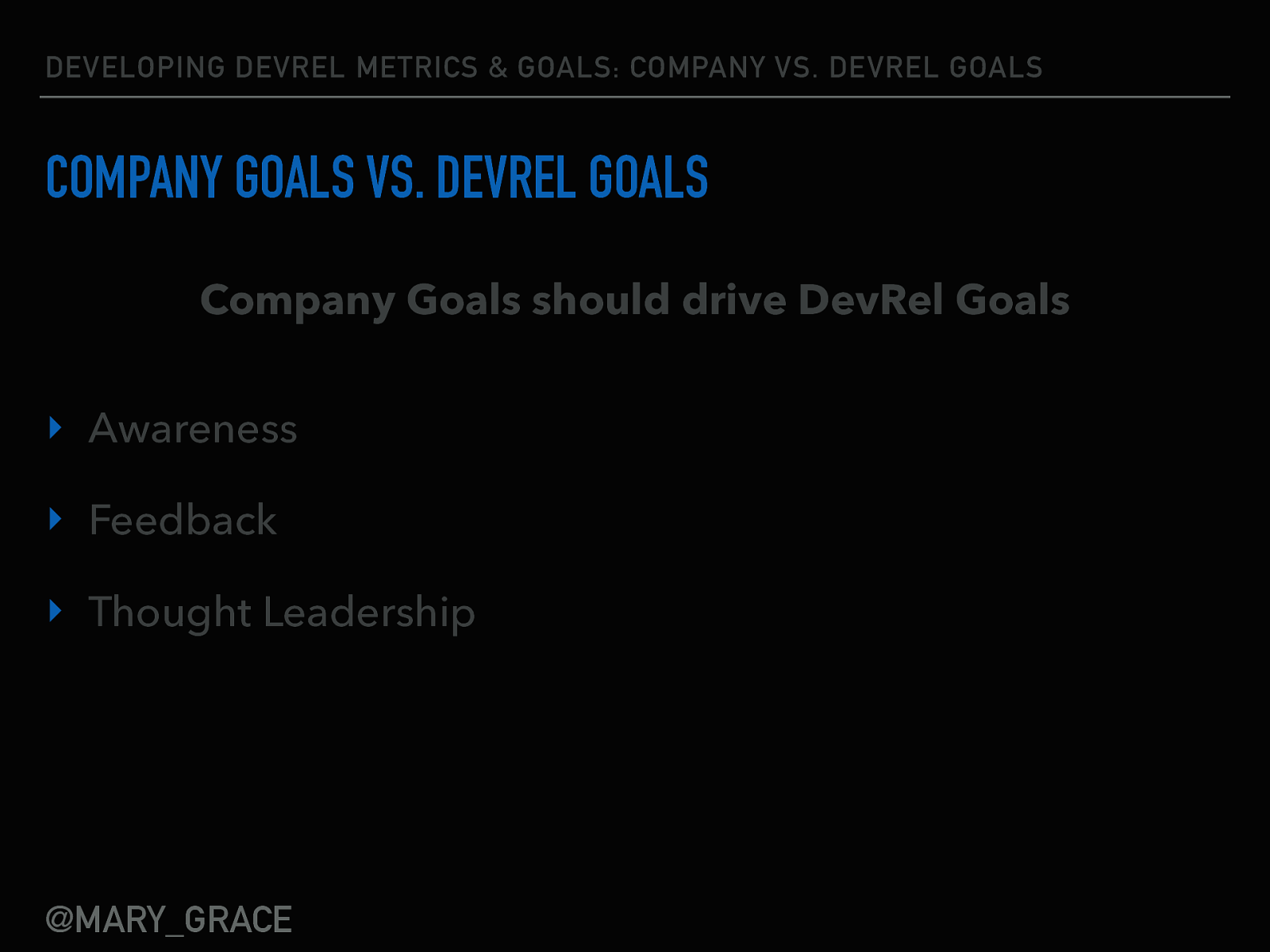
DEVELOPING DEVREL METRICS & GOALS: COMPANY VS. DEVREL GOALS COMPANY GOALS VS. DEVREL GOALS Company Goals should drive DevRel Goals ‣ Awareness ‣ Feedback ‣ Thought Leadership @MARY_GRACE One thing to keep in mind: The DevRel goals should always be traced back to the company goals. If the DevRel team isn’t working toward the company goals, there’s no solid reason to keep them around and the whole team is likely to be cut, because the executives won’t be able to understand the business value. These goals could be anything from driving awareness to gathering feedback or providing thought leadership content that will benefit the larger technical industry but also set the company up as a source of relevant industry content.
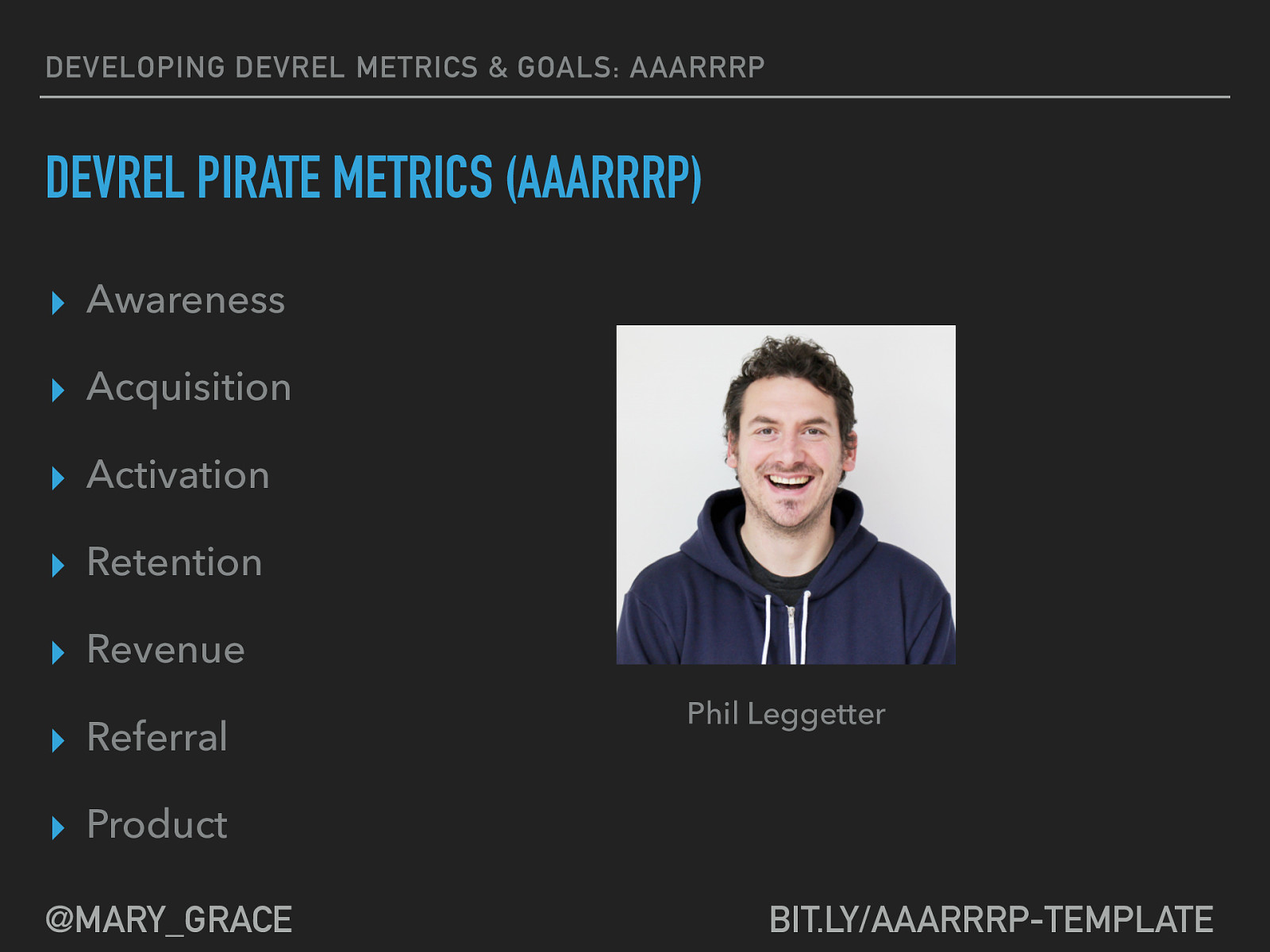
DEVELOPING DEVREL METRICS & GOALS: AAARRRP DEVREL PIRATE METRICS (AAARRRP) ▸ Awareness ▸ Acquisition ▸ Activation ▸ Retention ▸ Revenue ▸ Referral Phil Leggetter ▸ Product @MARY_GRACE BIT.LY/AAARRRP-TEMPLATE TIME CHECK: 10:10AM Phil Leggetter — previously the head of DevRel at Nexmo came up with a version of Pirate Metrics (coined by Dave McClure) for DevRel: • ** Awareness - general knowledge of the product and what it does • Acquisition - users coming to the site from various channels, resulting in a sign-up • Activation - product implementation (e.g. makes first API call) • Retention - continual use of your product • Revenue - pays for usage (e.g. subscribe, buy product, etc.) • Referral - refer others (become brand ambassadors) • ** Product - provides feedback or contributes to your product These metrics represent the behavior of our customers and help us understand the different stages of engagement which can be influenced by DevRel. There are some that we’ll be more involved in: awareness and product for instance. There are others that will be tangentially related: acquisition (ppl coming to the site bc of your tweets, talks, etc.), activation (someone had a good experience and were able to quickly and easily make their first API call — DevEx), or referral bc of good experiences that we’ve contributed to. And lastly, there are some that are more outside of our normal day-to-day, but that our work contributes to on a longer-tail / more long-term basis: retention and revenue. We absolutely impact these, but they aren’t within our normal range of goals and metrics. ** CLICK THROUGH ** on link to transition over to template / spreadsheet What items fall into these categories for your business will depend on what your specific team is involved in and what your goals are, but this is an example of some of the tasks that could fall to you!
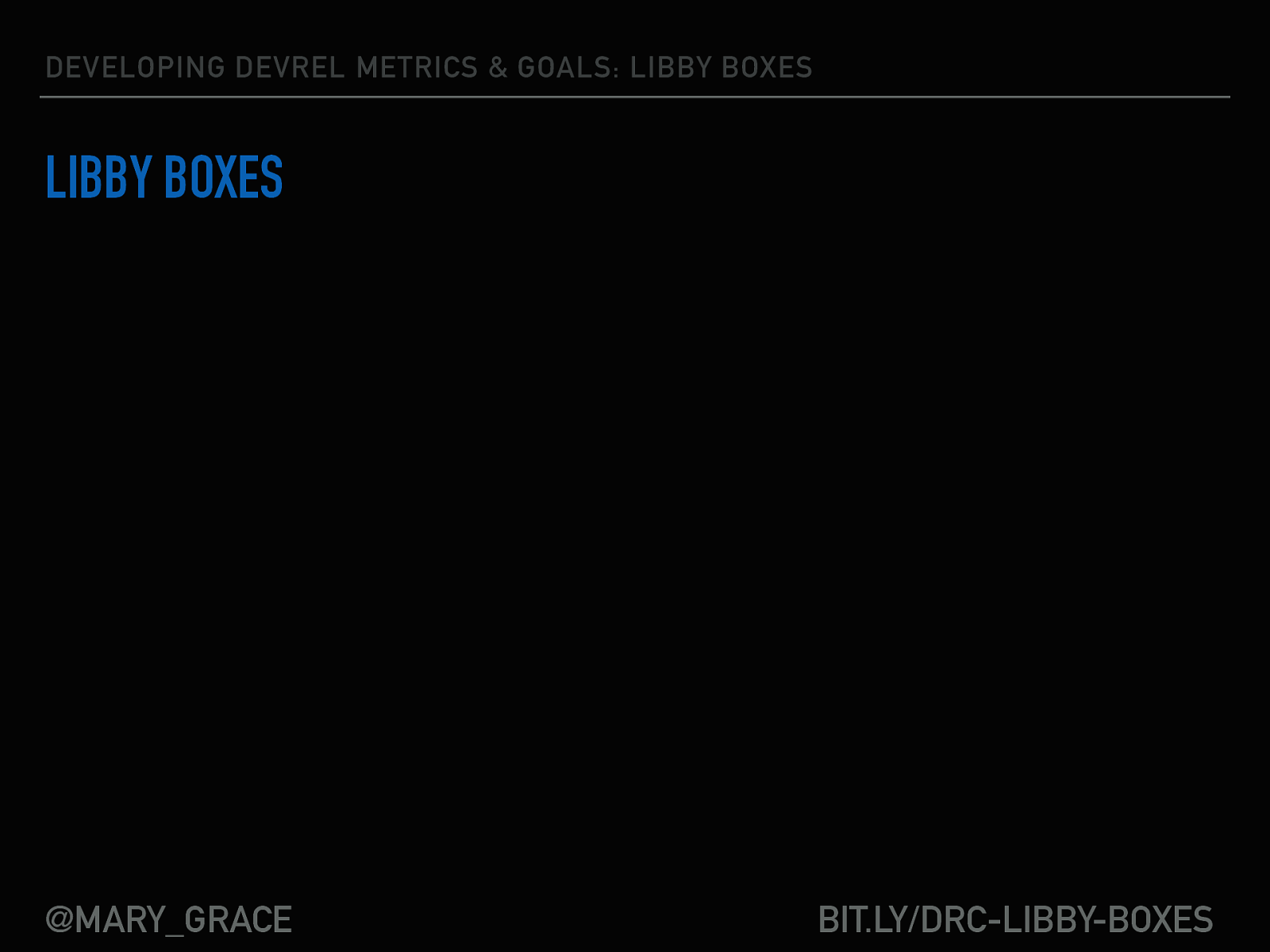
DEVELOPING DEVREL METRICS & GOALS: LIBBY BOXES LIBBY BOXES @MARY_GRACE BIT.LY/DRC-LIBBY-BOXES TIME CHECK: 10:15AM This framework is used to illustrate the relationship between the strategic objectives that you’re trying to achieve and the initiatives (or levers) that you use to reach those goals. In short, they’re a way to trace your everyday actions and deliverables back to the overarching company goals that you’re trying to push forward. This direct line makes it easier to prove that your efforts, while unconventional, are making a difference for the company.
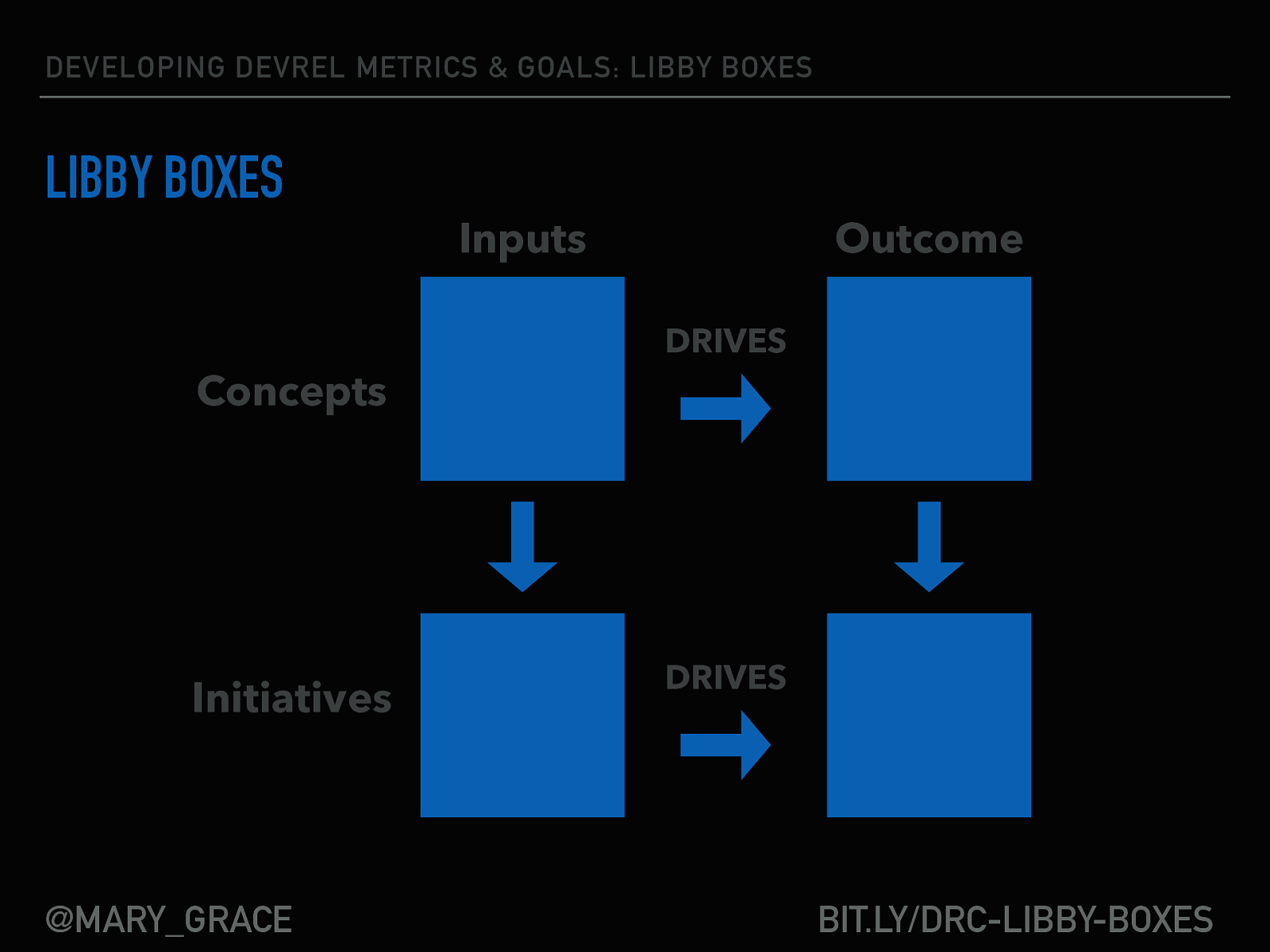
DEVELOPING DEVREL METRICS & GOALS: LIBBY BOXES LIBBY BOXES Concepts Initiatives @MARY_GRACE Inputs Outcome DRIVES DRIVES BIT.LY/DRC-LIBBY-BOXES The top row of Libby Boxes is for the concepts, or ideas. Once you have your idea (or hypothesis) identified, now you are ready to think about how you could measure those concepts you have listed in the top boxes. In the example used below, we cannot directly measure customer engagement; how could we measure things related to customer engagement to find an answer? These are the things we would list in the bottom row of boxes: Initiatives. Top right: What outcome are we striving for? Which pirate metrics are impacted? Top left: What will help us achieve that outcome? Bottom left: How can we measure our progress toward that outcome? Bottom right: What objective measures can we put in place?
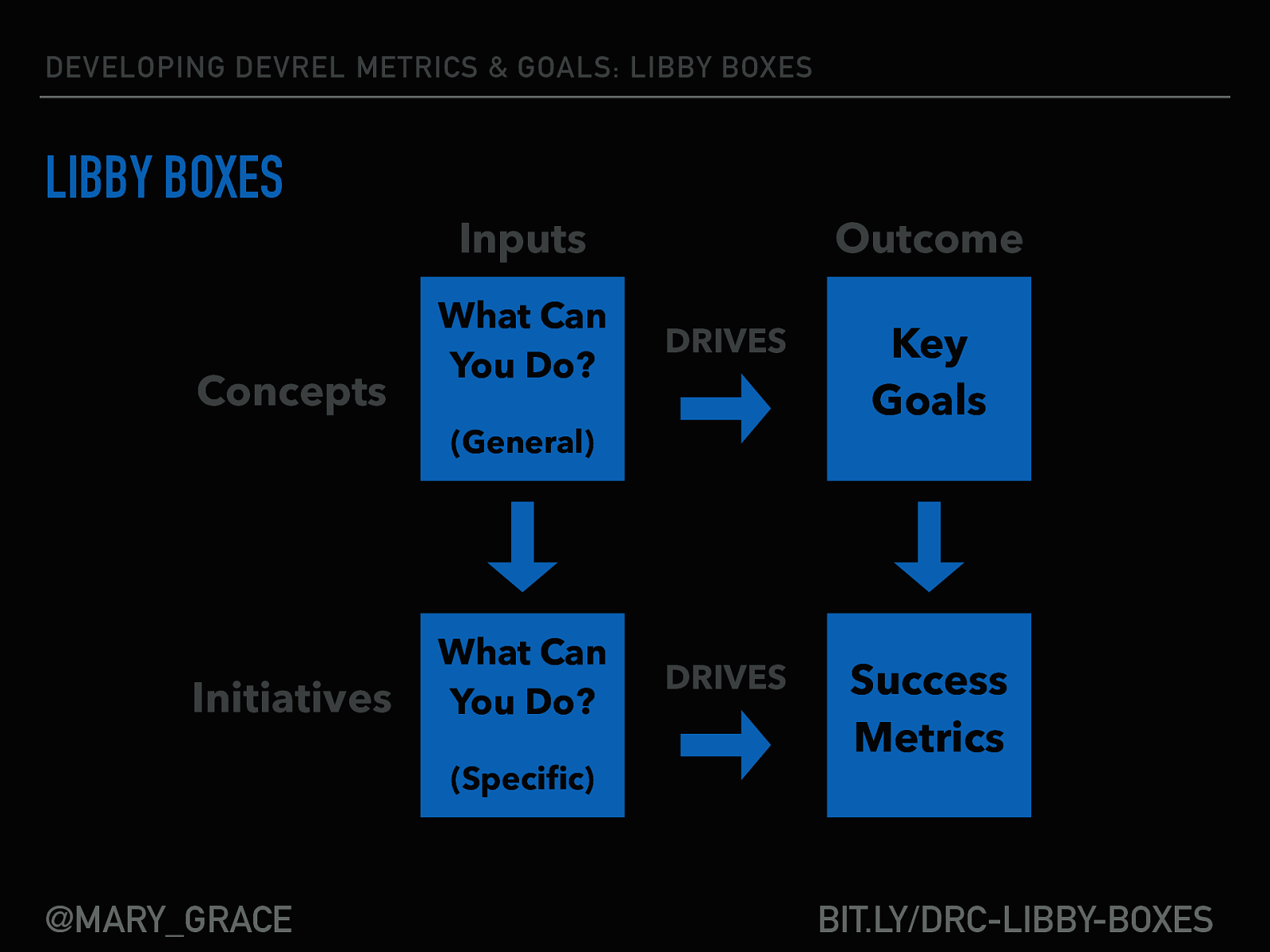
DEVELOPING DEVREL METRICS & GOALS: LIBBY BOXES LIBBY BOXES Concepts Inputs What Can You Do? Outcome DRIVES Key Goals DRIVES Success Metrics (General) Initiatives What Can You Do? (Specific) @MARY_GRACE BIT.LY/DRC-LIBBY-BOXES Another way to look at this is the following:
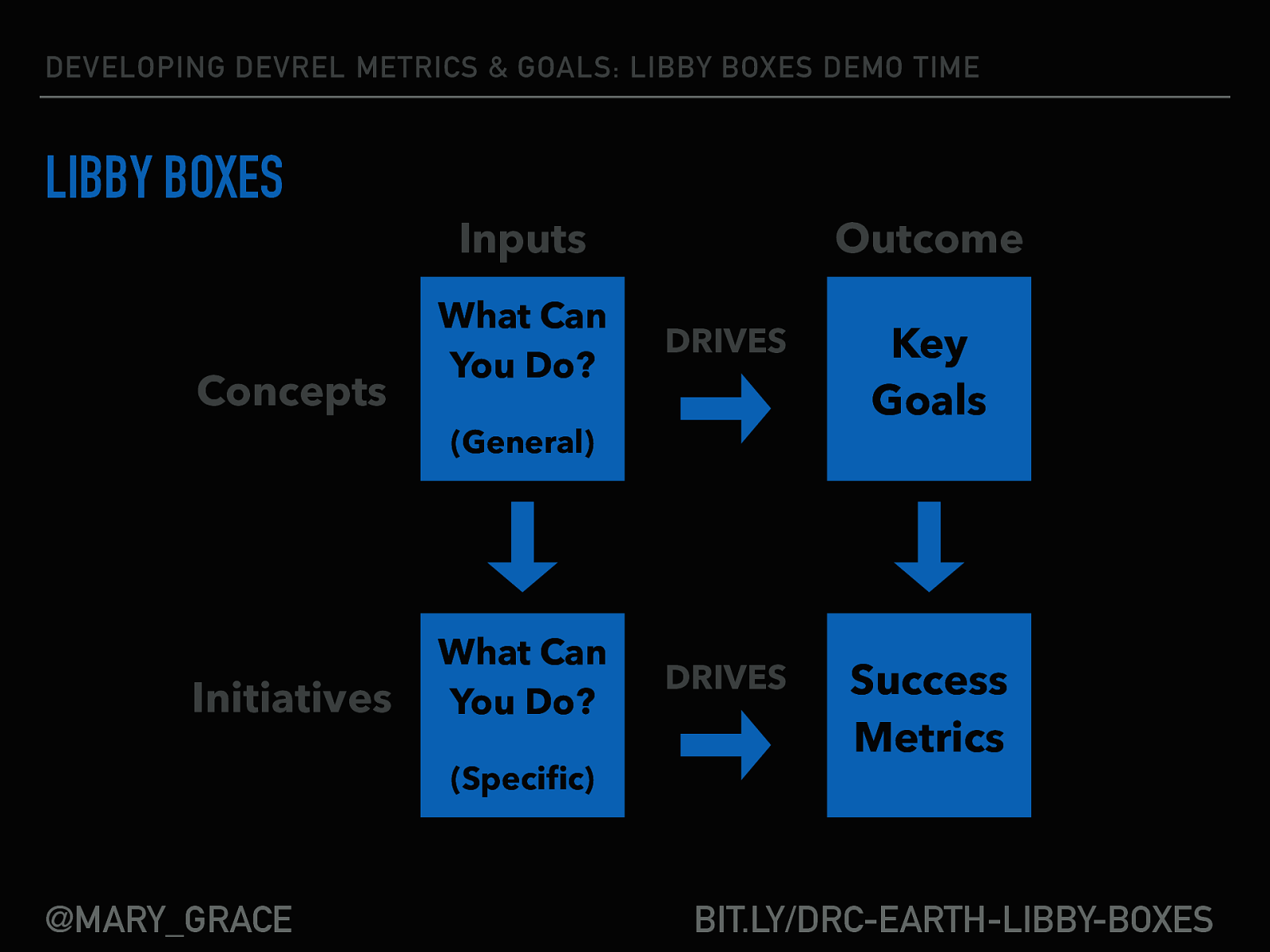
Decide on one goal (upper right) Which AAARRRP metrics does this fulfill? (wait for Slack) What are some of the general buckets of things we can do to push the concepts forward? (post in Slack) In Slack, let’s write down all of the possible activities that you can think of which fall into those buckets. Also feel free to throw out a success metric for that task — how many blogposts in one quarter with a team of 5? how many conferences can we speak at? - I’ll give you 5, maybe 10m and we’ll come back together to walk through all of the “dig deeper” and “reasonable measures of success” buckets. Feel free to use this time to take a quick bio break or grab some water as well. Time Check: 10:30ish
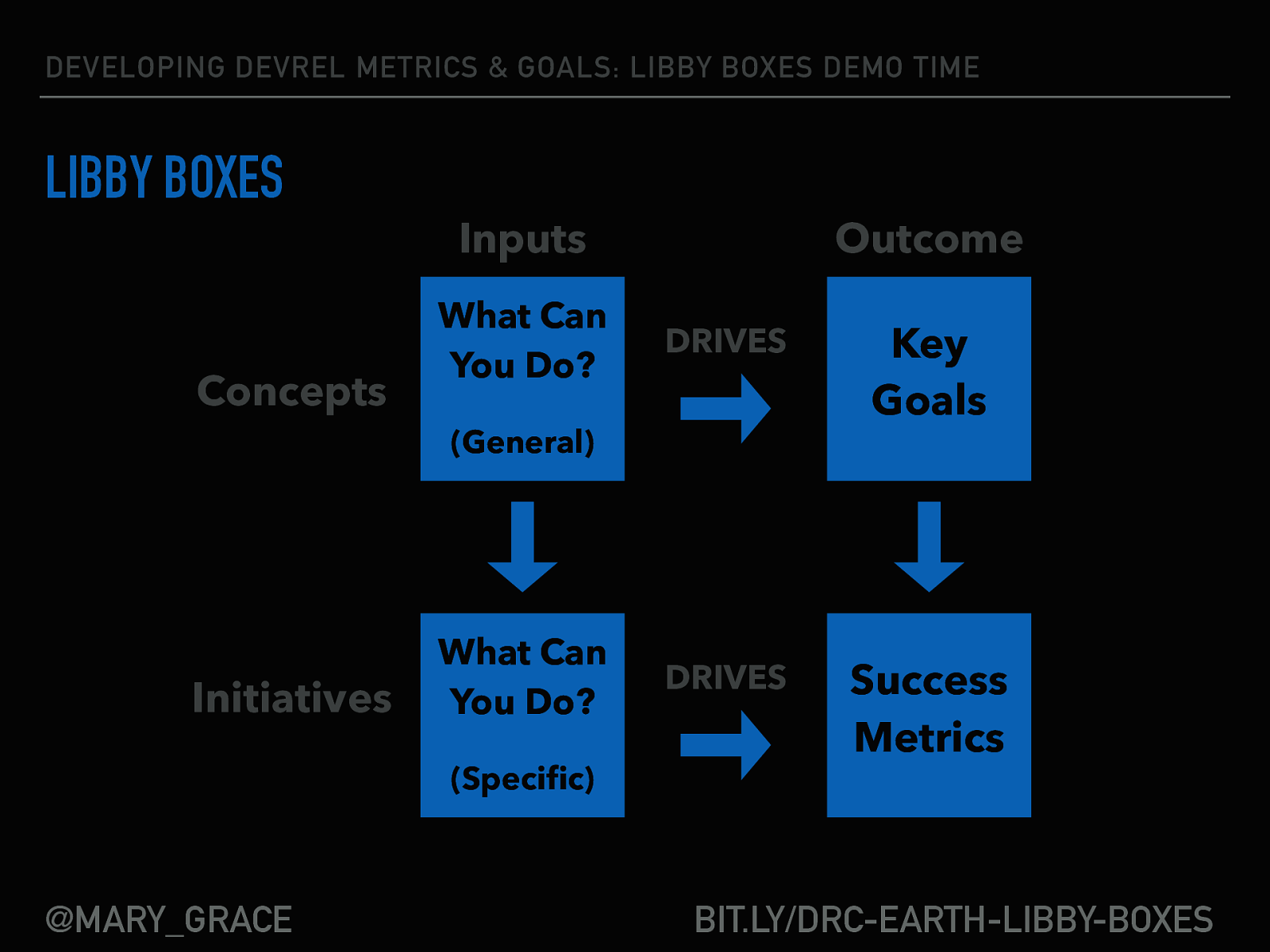
DEVELOPING DEVREL METRICS & GOALS: LIBBY BOXES DEMO TIME LIBBY BOXES Concepts Inputs What Can You Do? Outcome DRIVES Key Goals DRIVES Success Metrics (General) Initiatives What Can You Do? (Specific) @MARY_GRACE TIME CHECK: 10:40AM (10m left of Libby Boxes) Alright… let’s talk through those specific initiatives you came up with. Who wants to go first? List them all out. And what’s our success metric for that? How do we know if we’re successful? BIT.LY/DRC-EARTH-LIBBY-BOXES
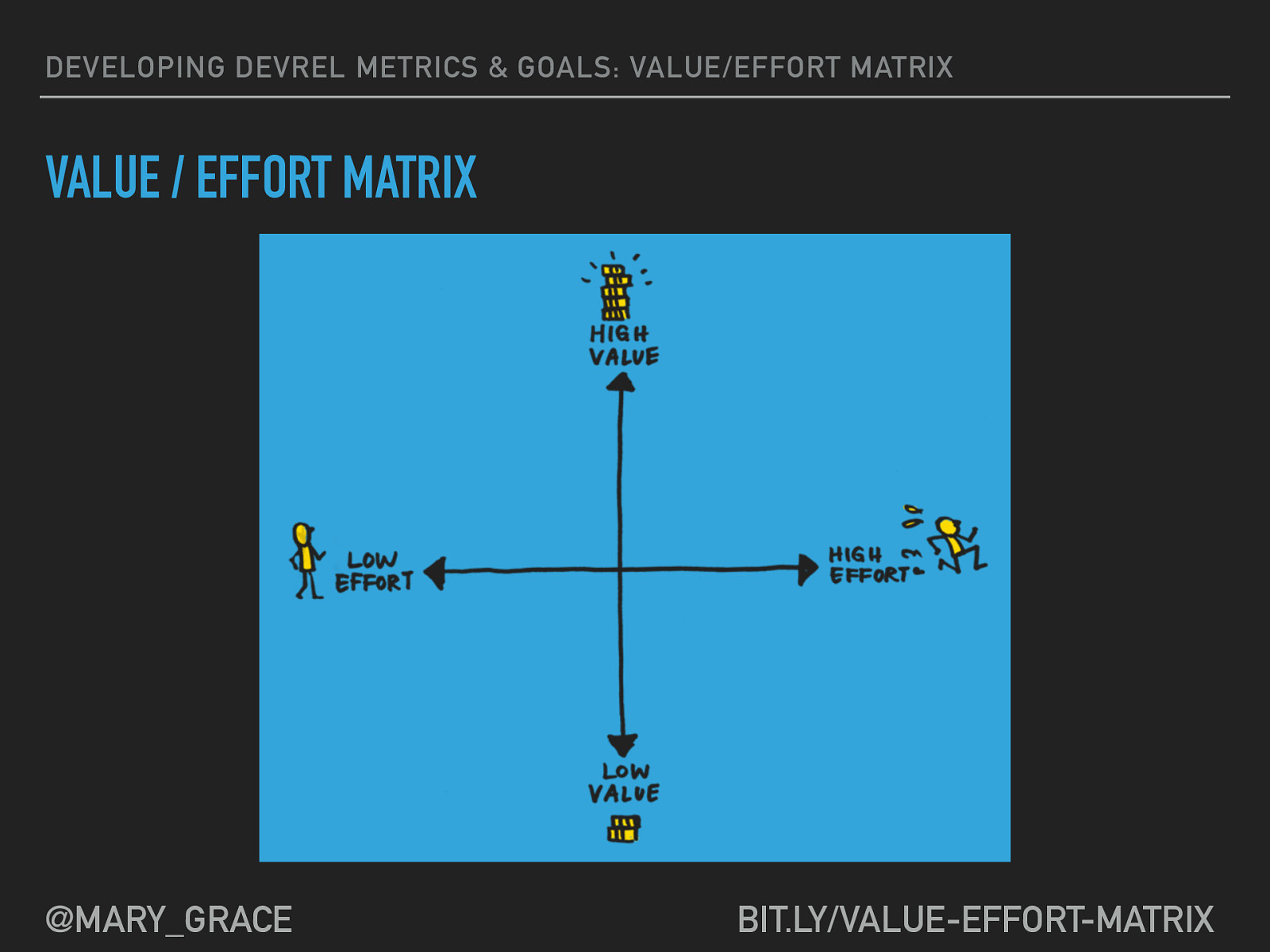
DEVELOPING DEVREL METRICS & GOALS: VALUE/EFFORT MATRIX VALUE / EFFORT MATRIX @MARY_GRACE BIT.LY/VALUE-EFFORT-MATRIX TIME CHECK: 10:55AM Here’s the basic idea: Every task can be scored with respect to effort (how much time or energy does it take) and value (not always monetary — sometimes how big or important of a win or much of an impact it has on the community). By brainstorming tasks and putting them up on this matrix, we can narrow down what tasks we should be prioritizing. Think about it in this way: - High value, High effort items tend to be big projects and should be broken down into smaller chunks, then put the matrix again. - High value, Low effort items should be done ASAP — these are quick wins that are incredibly important to others throughout the company seeing your value as a team. - Low value, Low effort items can be done on a Friday afternoon when folks aren’t motivated but need work to do OR when there’s a lag in the backlog. - Low value, High effort items shouldn’t be dealt with yet. There’s not enough value that comes out of them to justify the large amount of work. Let’s map all of these items out on our value/effort matrix.
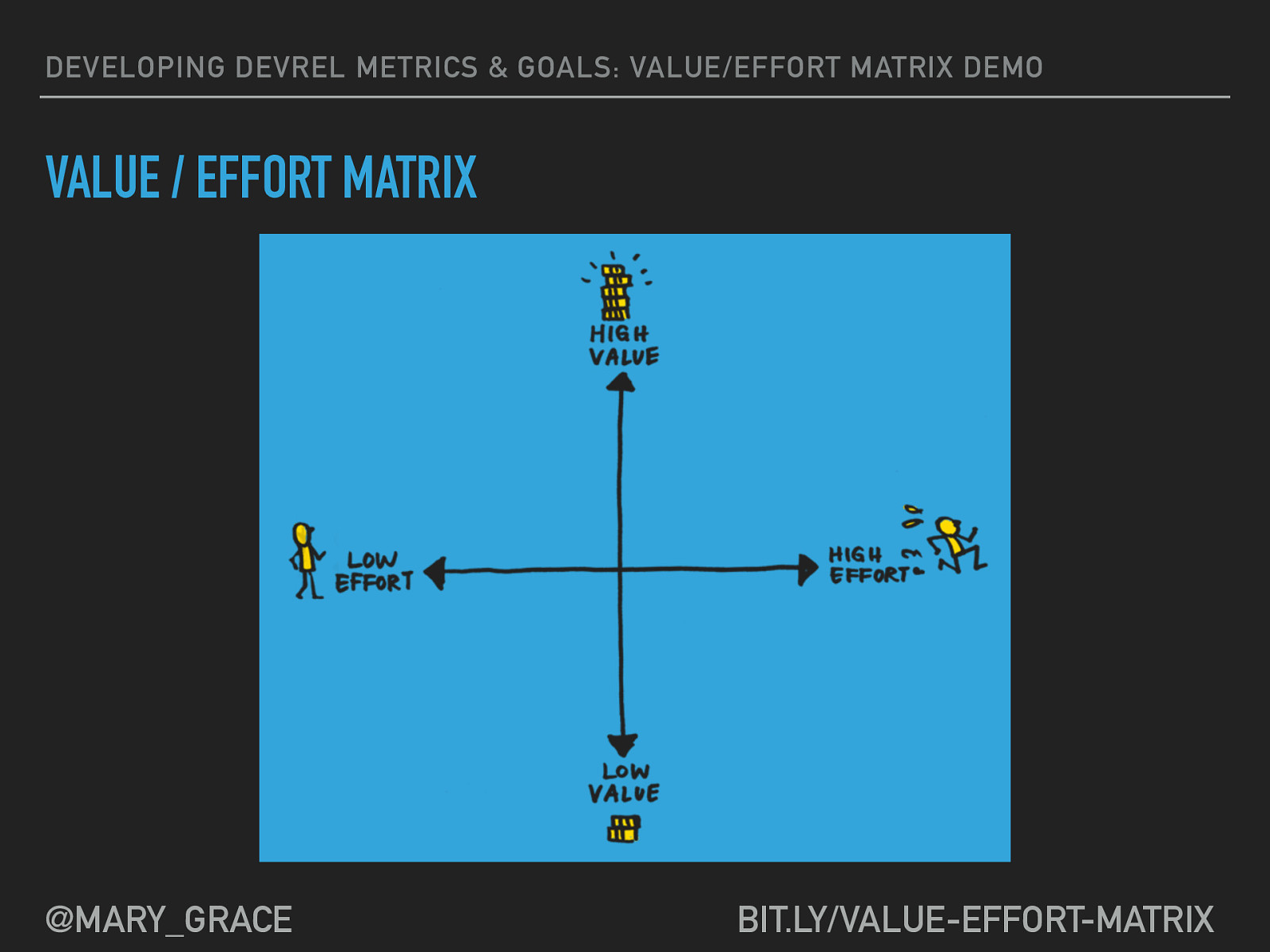
DEVELOPING DEVREL METRICS & GOALS: VALUE/EFFORT MATRIX DEMO VALUE / EFFORT MATRIX @MARY_GRACE * * * * BIT.LY/VALUE-EFFORT-MATRIX talk about strengths in the team — what’s easier for some won’t be as easy for others. play to strengths. look for areas of career progression. what excites you? what just has to be done? dependencies delegate, delete, do, ?? if still too many post-it’s, which ones bring the most value with the least amount of effort? which ones have to be done first in order to unblock others? which ones have the most impact on the company versus the community? ^ depending on your current status with the company will determine whether you’re in a comfortable place politically to focus on community versus company impact.
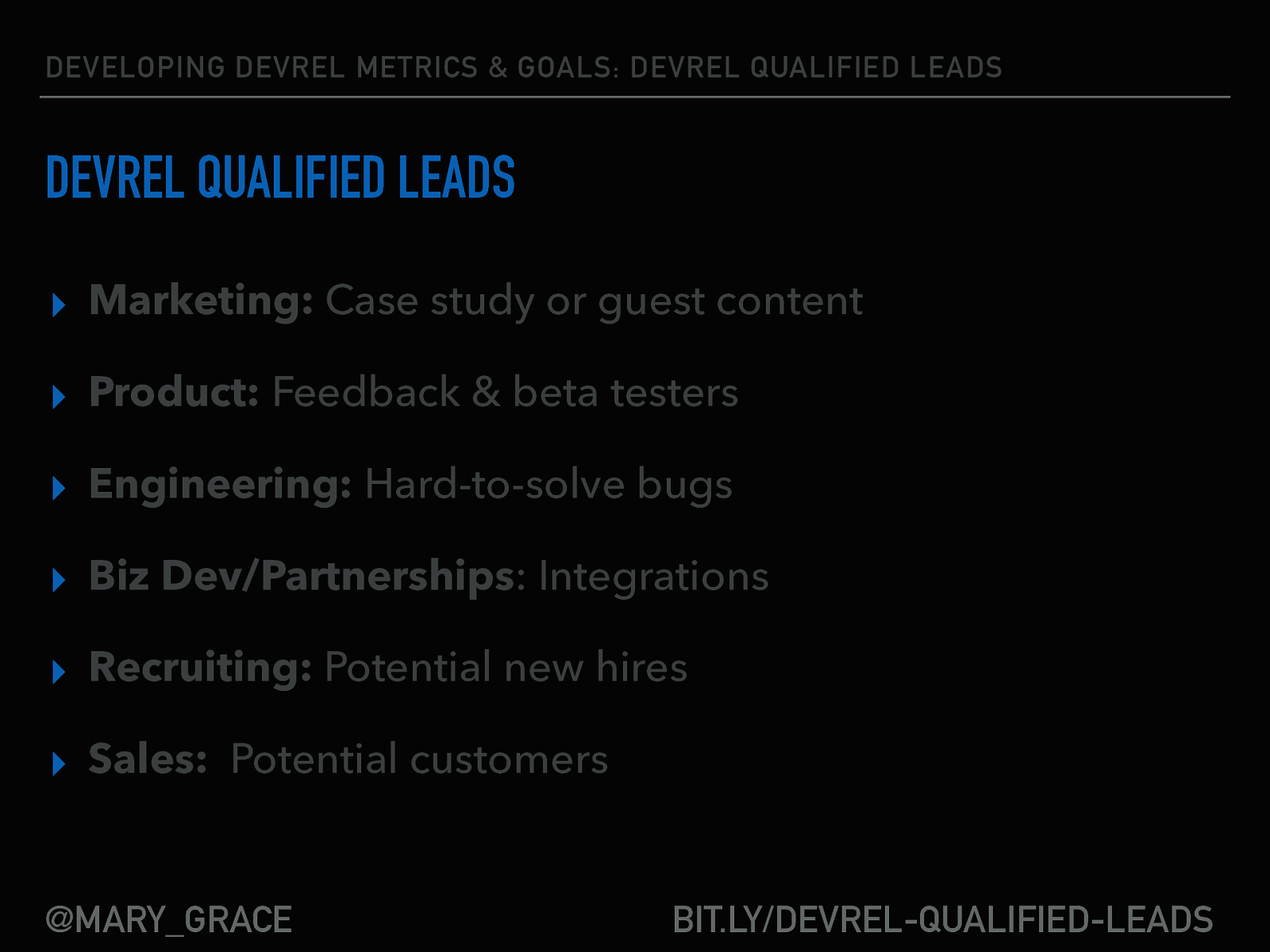
DEVELOPING DEVREL METRICS & GOALS: DEVREL QUALIFIED LEADS DEVREL QUALIFIED LEADS ▸ Marketing: Case study or guest content ▸ Product: Feedback & beta testers ▸ Engineering: Hard-to-solve bugs ▸ Biz Dev/Partnerships: Integrations ▸ Recruiting: Potential new hires ▸ Sales: Potential customers @MARY_GRACE BIT.LY/DEVREL-QUALIFIED-LEADS TIME CHECK: 11:25AM One last thing I want to talk about before we wrap up… I rarely put them as their own item because they’ll be happening in the midst of everything else, but they’re absolutely a metric to track! I have a link to a blogpost with more information at the bottom of the screen if you want to learn more. Here’s a quick overview: I came up with this term after meeting with yet another team who had metrics traditionally given to sales (how many people signed up for an account this month?), recruitment (how many applicants did we get this month?), or marketing (how many leads did you get at that conference?). These are all things that DevRel and Community Professionals have zero control over. Who knows whether the person you met at the most recent conference will even apply for the job, let alone whether the hiring manager will hire them. Maybe their application won’t make it through the system because of the one quirky thing about their education, or perhaps they don’t click with the hiring manager. Whatever the case may be, you can’t be held responsible for whether or not that individual got hired… you have no say as far as salary, compensation, or any number of other negotiating factors go, or whether they’ll be a good fit with all of the other team members. So what does this look like? <CLICK> Maybe you’ve encountered someone who’s answering questions on your forum consistently and has obviously had a very good experience with your product. They might be a good contact to pass off to Marketing for a Case Study. Or perhaps they’d be interested turning some of their longer forum pieces into a blogpost. If you’re getting exceptional feedback from a technical individual, passing them direct to Product might be a good idea. They’ll be able to have a longer-form conversation with them and parse the important pieces rather than you playing messenger. Or if you’re getting close to rolling out a new feature that a handful of community members have been asking for for some time, perhaps you pull them in before it’s released to the public for beta testing. Or perhaps a community member has stumbled on a particularly hard-to-solve bug and is willing to help your engineering team reproduce it and get to the bottom of it. Maybe you’ve run into a Developer Advocate at another company who’s willing to help build out an integration that will help customers use your products in tandem. Your Business Development or Partnerships team would be more than happy to handle that conversation going forward. On occasion, we’ll come across community members who just get it. They click with everyone at the company. They understand the product. They’re passionate about the cause. They’re already contributing during their free time anyway… so when a position opens up, they’re a perfect person to pass off to recruiting. And of course, sales. Depending on the person you’ve met in the community will determine who exactly in sales you pass them off to— whether you start with the solutions architect or solutions engineer — typically the technical side